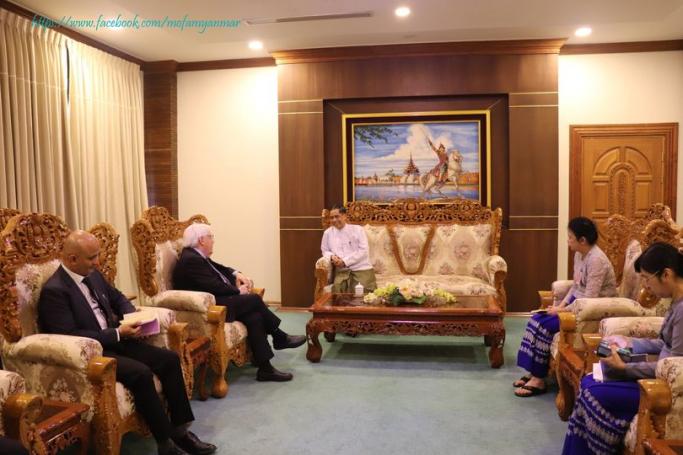Commentators and critics have expressed shock and concern over this week’s visit by Martin Griffiths, the United Nations Under-Secretary-General for Humanitarian Affairs and Emergency Relief Coordinator to meet with the Myanmar generals in Naypyidaw.
Mr Griffiths met with junta leader Min Aung Hlaing and other top generals on 15 August in Naypyidaw, a visit extensively covered by junta-media on 16 August in which the junta complained about international “misinformation” over media coverage of the junta’s aid work in the wake of May’s Cyclone Mocha.
The United Nations Office for the Coordination of Humanitarian Affairs (OCHA) has been trying for months to get the Myanmar junta to allow in international humanitarian aid, largely without success. Although some international and local aid has reached cyclone victims, hundreds of thousands if not millions of people in need are said to still be waiting for help.
It is not known in detail what agreements were reached between the junta and the head of UN OCHA regarding humanitarian assistance during the meeting.
Mr Griffiths ’visit and photos of him shaking hands with Min Aung Hlaing have prompted observers to raise the alarm.
“What on earth is the UN thinking?” former US Ambassador to Myanmar Scot Marciel asked in a 16 August post on X (formerly Twitter).
Dr Ronan Lee, Myanmar expert and former UK MP, said the Myanmar junta is the cause of the humanitarian crisis and that the UN should stop giving the junta these photo opportunities.
NGO Progressive Voice posted on X: “@UNReliefChief meeting Min Aung Hlaing raises alarm & is yet another UN's failure to support #Myanmar people & falsely lends legitimacy to terrorist junta. Channeling aid thru junta will only enable them to weaponize aid while the nation witnesses heightened violence.”
Chris Gunness of the Myanmar Accountability Project posted on X: “I was a UN official in Bosnia when senior officials talked to war criminals about visas/access while hundreds of thousands were slaughtered. Member states were also v late to act. The same thing is happening today in Myanmar. Has the UN learned nothing?”
May Wong, Channel News Asia correspondent, posted on X: “No surprise news of high-ranking #UN official @UNReliefChief dominated #Myanmar state media front page & more. What's different now is headline/article focused entirely on #military's own narrative, accusing global community of relying on ‘misinformation’.”
Democracy activist Igor Blazevic wrote a long critical blog post on social media. “Junta is already running its propagandistic mill in full swing by using opportunity of the high-profile visit to provide international audience – and even more domestic audience – with the “accurate information on Myanmar’s situation”.
“Junta spokespersons and propagandistic outlets will now for a few days flood us with ‘accurate information ’about ‘political progress in Myanmar ’under junta, and about ‘State responsibilities being taken by the Tatmadaw under the Constitution (2008) for occurrences of voting fraud in the 2020 multiparty democratic general elections’.”
Activist Blazevic claims there were hidden reasons for the high-profile UN humanitarian aid representative’s visit to Naypyidaw, saying it was part of efforts by the relevant UN offices to secure visa’s and maintain a UN representative foothold in the country. He also suggested this visit might help the UN to make a call to donor countries to send in funds for the Myanmar humanitarian crisis.
Griffiths ’visit follows several other visits by UN humanitarian representatives to Naypyidaw, photographed and documented by the Myanmar junta in their media, that have failed to break the deadlock over the delivery of international humanitarian aid to those in need in the wake of Cyclone Mocha.
It is three months since the devastating cyclone hit Myanmar, particularly Rakhine State which bore the brunt of the storm. Although the death toll of just over 140 people was relatively low – compared to 2008 Cyclone Nargis which killed 138,000 – critics claim the current Myanmar junta is using humanitarian aid as a weapon, blocking most of it, and only allowing it through to areas perceived to be “pro-junta”.
Critics have asked why the UN is not trying to deliver aid through the National Unity Government, Civil Society Organizations and Ethnic Revolutionary Organizations, rather being reliant on the junta that has been tying up aid delivery in red tape.












